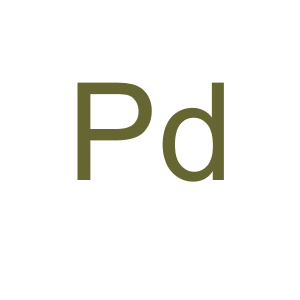Title: Palladium
CAS Registry Number: 7440-05-3
Literature References: Pd; at. wt 106.42; at. no. 46; valences 2, 4. Group VIII (10). Six naturally occurring isotopes: 102 (1.0%); 104 (11.0%); 105 (22.2%); 106 (27.3%); 108 (26.7%); 110 (11.8%); artificial, radioactive isotopes: 98-101, 103; 107; 109; 111-115. Abundance in earth's crust 0.001-0.01 ppm. Discovered in 1803 by Wollaston. Belongs to the platinum group of metals. Occurs in nature alloyed with platinum or gold and as a selenide; found in nickel sulfide ores; found in the minerals stibiopalladinite, braggite, porpezite. Isoln: Vauguelin
et al., cited by Mellor,
A Comprehensive Treatise on Inorganic and Theoretical Chemistry 15, 595 (1936). Reviews of prepn, properties and chemistry of palladium and other platinum metals: Gilchrist,
Chem. Rev. 32, 277-372 (1943); Beamish
et al., in
Rare Metals Handbook, C. A. Hampel, Ed. (Reinhold, New York, 1956) pp 291-328; Livingstone in
Comprehensive Inorganic Chemistry vol. 3, J. C. Bailar, Jr.
et al., Eds. (Pergamon Press, Oxford, 1973) pp 1163-1189, 1274-1329. Review of uses: E. M. Wise,
Palladium, Recovery, Properties, Uses (Academic Press, New York, 1968) 187 pp. Use of organic palladium derivatives in synthesis: P. M. Maitlis,
The Organic Chemistry of Palladium (Academic Press, New York, 1971); J. Tsuji,
Top. Curr. Chem. 91, 29 (1980); B. M. Trost,
Tetrahedron 33, 2615 (1977);
idem, Acc. Chem. Res. 13, 385 (1980).
Properties: Silver-white metal, face-centered cubic structure; occurs also as black powder and as spongy masses which can be compressed to a compact mass. mp 1555°. bp 3167°. d420 12.02. Hardness on Mohs' scale 4.8, Brinell hardness 61.0. Spec heat 0.0584 cal/g at 0°C. Electrical resistivity at 0° = 10.0 microohms-cm. Appreciably volatile at high temps. At a red heat is converted into the monoxide. Forms dihalides with fluorine or chlorine at a red heat. Reacts with nitric acid, sulfuric acid, a mixture of hydrochloric and chloric acids. Reacts slightly with concd HCl; more readily in the presence of air or free chlorine. Forms a sulfide when heated with sulfur, a phosphide when heated with phosphorus. Absorbs a considerable amount of hydrogen.
Melting point: mp 1555°
Boiling point: bp 3167°
Density: d420 12.02
Use: In form of gold, silver, and copper alloys in dentistry; for alloy bearings, springs, balance wheels of watches; for mirrors in astronomical instruments; as catalyzer in manuf of sulfuric acid and in other oxidizing processes; in powder form as catalyst in hydrogenation and in ignition of hydrogen or hydrocarbons with oxygen; the spongy form is used in gas analysis for separating hydrogen from mixtures of gases.

